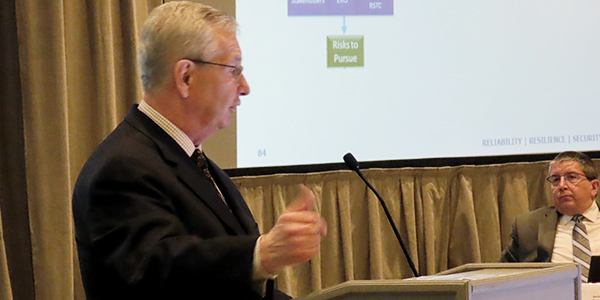By Holden Mann
MANHATTAN BEACH, Calif. — NERC and its collaborators are developing a framework for prioritizing known and emerging risks that they soon hope to hand off to the Reliability Issues Steering Committee (RISC) for further refinement.
Speaking to NERC’s Member Representatives Committee Feb. 5, NERC Chief Engineer Mark Lauby said that while NERC and the industry have “a host of different tools in our toolkit” to mitigate risk, the agency lacks a transparent process to help entities choose the best approach to manage a particular situation. The proposed framework is intended to fill this important gap.
“It seems like otherwise we just hold the risk up; we don’t really know what to do with it [and] what’s the best solution,” Lauby said. “With our eyes open, [we’ll be] able to take some action.”
Lauby described the preliminary framework — which he said was created by the ERO Enterprise, with additional input by the North American Transmission Forum — as a move toward this unifying approach, albeit one that still needs considerable revision before it is ready for deployment.
Rationalizing Existing Procedures
The developers’ work so far has focused on identifying six essential elements to be performed by ERO Enterprise participants including RISC and the new Reliability and Security Technical Committee (RSTC):
- Identifying risks and creating a risk registry.
- Prioritizing risks.
- Identifying and evaluating mitigation strategies.
- Deploying mitigation strategies.
- Measuring the strategies’ success.
- Monitoring the residual risk.
For this early stage the designers of the framework leaned toward incorporating existing processes into the new framework — for example, RISC already performs the prioritization function through its annual Reliability Risk Priorities Report. Lauby said that while “certainly we didn’t come up with” these functions, the work of the existing bodies could still go to waste if they are not integrated into a consistent procedure.
Guiding Principles Established
In addition to creating the basic framework, the designers also suggested a set of principles to guide how the ERO Enterprise prioritizes risk and decides on a specific response. Events are grouped into four main quadrants based on their likelihood and their potential impact on the grid. Low likelihood, low impact events can be addressed with robust baseline reliability requirements, while high impact events with a high likelihood should be dealt with through more active means such as NERC alerts and in-person assist visits.
The framework is still in a very early stage and has mainly been developed at a high level. As a result, NERC’s leadership sees a long road ahead before it takes a form that can be adopted by the ERO Enterprise and industry. Nevertheless, Lauby believes the work already done constitutes an important first step.
“Consider it — as we say in our transformation language — a mistake,” he said. “A lot of good ideas are there to begin with, but my suggestion will be to hand this off to the RISC [because] one of the things [assigned to] it … in the charter is to triage risk.”





